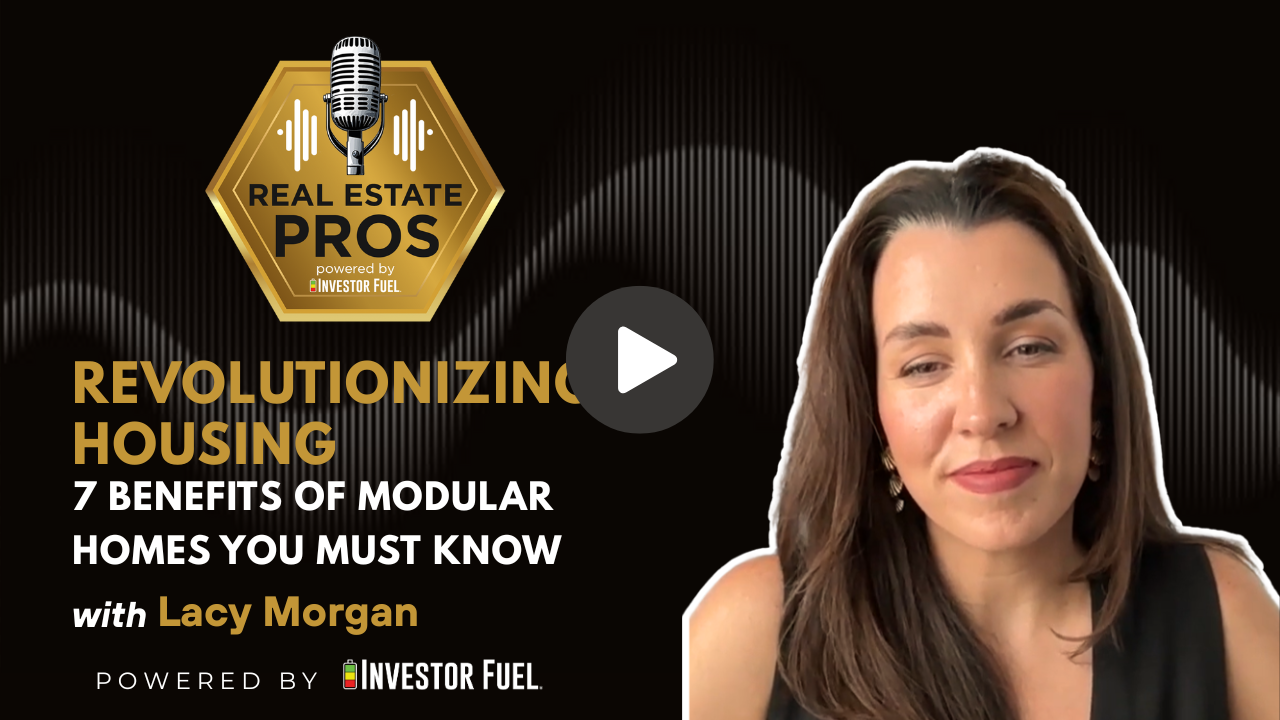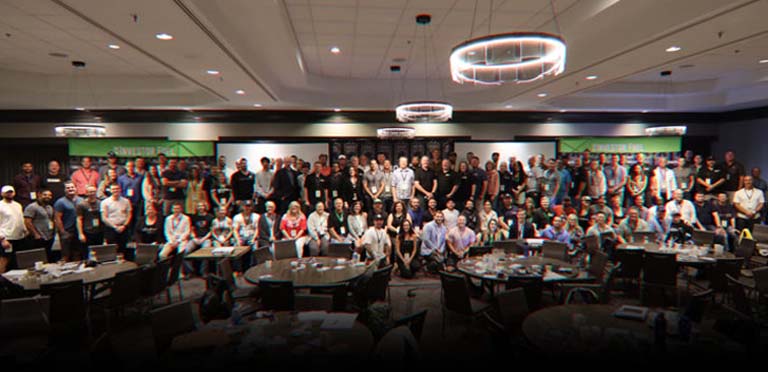
Show Summary
In this conversation, Dylan Silver interviews Lacy Morgan, an advocate for offsite prefab modular construction, discussing the evolution and benefits of modular homes in addressing the housing crisis. Lacy shares her journey into the real estate space, the differences between modular and manufactured homes, and the growing demand for affordable housing solutions. The discussion also covers customization options, financing opportunities, and the importance of educating realtors and the public about modular construction. Lacy emphasizes the potential of offsite construction to revolutionize the housing market and improve accessibility for families.
Resources and Links from this show:
Listen to the Audio Version of this Episode
Investor Fuel Show Transcript:
Dylan Silver (00:01.443)
Hey folks, welcome back to the show. I’m your host Dylan Silver. And today on the show I have Lacy Morgan, a passionate advocate for offsite prefab modular construction, solving the housing crisis with faster, more affordable solutions based at the Saddlebrook House Factory in Northeast Texas. She currently brings offsite construction solutions to investors and developers in the central United States. Lacy, welcome to the show.
Lacy Morgan (00:30.53)
Hi, thanks for having me Dylan. I’m so glad to be here.
Dylan Silver (00:34.039)
It’s a pleasure to have you. I always like to start off at the top of the show by asking folks how they got into the real estate space.
Lacy Morgan (00:42.998)
Yeah, so our journey is especially special. We actually had a ranch and, you know, my husband is a home builder. We’ve built off-site, ready-built homes for a long time. It’s relatively not as well known. A lot of people in the central United States have actually been building.
offsite construction. It’ doesn’t really know about construction really is hom place and then moved and foundation later. So my hea and we were working differe we had always had this dr more homes to more people grew up, I lived in a small had to share a bedroom w husband actually had his m
for Humanity Homes. for us, housing has just been very much a mission that we believe has been given to us in a divine way.
And so for us, you know, we kind of looked at our life and we had we had always had this mission in our heart. And we thought, you know what, it’s time to just sell everything and just go all in on bringing more homes to more people. So that’s exactly what we did. We sold our ranch and then we started working on opening up retail locations and then bridging the gap between all of these manufacturers out there in the world who do modular and offsite. And then also the developers and real estate investors who are looking to actually
you know, put more houses out there into the world. You have to have somebody on the ground acting as your construction management firm and that’s really what we do. So we kind of organize the entire project, bring that purchasing power from the factories to, you know, the people who are on the other side looking to build these developments in these communities.
Dylan Silver (02:31.319)
Lacy, when I think about this space, I think it’s gonna be booming if it isn’t already. And I’ve seen, and I haven’t, I’m not personally too well educated on it, so I’m glad to have you on here, but I’ve seen like online pictures of what looks like trucks like hauling whole homes. And I’m like, I don’t know if that’s real or not, but is it one of these situations where we’re seeing a lot of progression in this space from
Lacy Morgan (02:37.848)
Yes.
Lacy Morgan (02:49.794)
Yes.
Dylan Silver (02:57.689)
where it was 30, 40 years ago with mobile homes, manufactured homes. Now I’m hearing new terms, off-site modular. Are these homes very much like the homes that we would consider single-family brick homes or something along the lines of this?
Lacy Morgan (03:05.134)
Mm-hmm.
Lacy Morgan (03:09.198)
Absolutely.
Absolutely. So the innovations within the manufacturing space, originally when you thought of modular or mobile homes, you thought of a manufactured HUD house. So this is going to be a home that meets certain requirements, but not our regular IRC codes. So these homes would have trailers and axles underneath them, usually a VIN number, and they qualified for certain types of financing more similar to like an automotive loan. Well, now the modular, just because of the demand, we have so many people in this space where they can’t quite afford
a new home, but they can afford more than your average double-wide. And so we’ve seen that most factories have gone from being 100 % HUD-manufactured homes to now producing almost 30 % modular construction. These modular homes have no axles. They have regular floor joists. They are built stick-built. All of the same IRC codes that you see. We have higher roof pitches. So you’re seeing things like 6-12, 8-12 pitches.
And then a lot of times we have, when you’re looking at larger developments or multifamily, you’re seeing component construction where an entire portion of an apartment is done in one box and then they’re assembled right there on site on the location.
Dylan Silver (04:27.147)
Okay, so when we’re talking about this component construction type of thing. So this is, I’m trying to picture it in my head. So it’s like almost Legos for homes. So people are, it’s multiple and they’re building it on site.
Lacy Morgan (04:31.726)
Hmm?
Lacy Morgan (04:38.414)
Absolutely.
Yeah, absolutely. In the same way that you may have ever seen a double wide being in two sections. I mean, when you really think about it, that itself is a component. And so once we brought this, you know, this innovative engineering into the space, you’re seeing architects and engineers who are who are building, you know, these types of floor plans where you have multiple pieces that are being able to be trucked in and then constructed in different manners. So we’re talking multi stories, you know, three sections wide. It’s just really it’s
really amazing and what’s crazy about this Dylan…
is that most of this type construction has existed for a long time in the United States, especially in the northeastern part of the United States, because their weather is so bad that they had to do a lot of their construction indoors inside of factories. But here in Texas, Oklahoma, Arkansas, Louisiana, we’re just now seeing this really move into our region because we couldn’t originally those factories couldn’t compete with on site construction costs. But what’s happened with the change of
Dylan Silver (05:43.343)
Hmm.
Lacy Morgan (05:45.472)
with COVID and all of the changing of inflation, we’re actually seeing that manufactured factory built housing and offsite construction is competitive or more affordable than your onsite builder. And honestly, it’s a long time coming. We don’t buy a truck at the dealership and then have them build it over 18 months, sending six different crews in your driveway. So housing has been, it’s been coming for a while that we’ve needed to see some technological innovation. And that’s really what offsite construction is.
Dylan Silver (05:59.567)
Ciao.
Lacy Morgan (06:15.376)
and it’s just an exciting thing to be a part of.
Dylan Silver (06:18.145)
Now, when I think of the options for people to acquire land and to buy a home, I think most people are still in the mindset of, have to go get qualified, I gotta be looking at homes, do I go new build, do I go something that’s been rehabbed, am I gonna be buying a condo, do I gotta move to a different area? So this throws another.
you know, tool into the equation here, a number into the equation here. Is this something that people are actively seeking out or is this something that maybe their realtor is suggesting to them? Is this something that they’re finding out through a Google search? How are people getting into this space if they’re maybe a first time home buyer?
Lacy Morgan (07:03.618)
Yeah, so most of our residential buyers are…
actually finding this on their own. They’re so desperate to find a home that’s in a more affordable range with a smaller square footage. Because you know what happened when all those interest rates went down and we were building like crazy, we didn’t think about square footage. And if you remember back in the 80s when we had inflation going up so high and interest rates went high, what did we do to respond? We went with smaller square footages that made our pricing more affordable, but our market just has not caught up. And so people are desperate.
alternative options on their own. And that’s really what’s happened. you we have a Facebook group with over half a million people inside of it. Our Instagram, our YouTube channels, they’ve just exploded because people honestly just have been starving for something like this. The search rankings for the word modular has just exploded over the last few years because they are looking for some sort of alternative. You know they don’t want to be mobile home so they think well maybe we should check out those modulars. I’ve heard that before.
Dylan Silver (07:38.734)
Yeah.
Lacy Morgan (08:06.768)
or maybe they’re not so bad, they qualify for regular mortgages. And so really we’re just showing up to meet that need and really, because all of these factories are there. This is what’s the most exciting part about this, Dylan, is all of those factories are there. We already have the infrastructure to produce homes. And not to mention, we haven’t even talked about speed, how fast this can be done. But we have the infrastructure to build all of these homes. We have the buyers out there who are looking for them.
we have to do is bridge that gap so that the on-site construction management is handled by people who understand how to manage modular, how to set them on-site, the kinds of challenges that we see with modular. And that really comes down to just educating other general contractors and builders around the nation so they understand how to handle modular. And we’re excited to be a part of that too, as not only do we provide that construction management service, but we actively seek to educate other builders.
Dylan Silver (08:55.812)
you.
Lacy Morgan (09:06.749)
on how to manage modular construction projects.
Dylan Silver (09:09.783)
Is there a difference, and you may have touched on this earlier, between modular and manufactured?
Lacy Morgan (09:14.574)
Absolutely. So a manufactured HUD home is going to have less walls inside of the building. going to have just the materials are not as high quality. It’s going to be set on top an actual frame. There’ll be axles underneath and it’ll be equipped with a VIN number. Generally, the roof pitch is never larger than a 412. You don’t have our 312, excuse me. You don’t have as many things like the overhangs on the eaves. Everything’s like
Dylan Silver (09:31.246)
Okay.
Lacy Morgan (09:44.528)
It’s visibly clear when you see it. You’re like, that’s a mobile home.
Dylan Silver (09:46.733)
Yeah. Okay. So this is interesting. So I’m familiar with like three distinct terms now. I’ve got mobile home, I’ve got manufactured home. I want to say manufacture was like a mobile home after a certain year. And now we have modular, which is like what we consider to be the homes that we see around this kind of right now. And I’m curious, you know, when people are reaching out to you and they’re saying, Hey, I’ve been looking into this.
Lacy Morgan (10:00.759)
Yes.
Lacy Morgan (10:07.246)
Mm-hmm.
Dylan Silver (10:14.861)
Modular home are they already have an idea of kind of what they’re interested in in getting are there like blueprints which they are able to see and or is it very much kind of like a I’m not even sure what what’s the what are the options that they have available to them?
Lacy Morgan (10:24.397)
Yes.
Lacy Morgan (10:31.991)
Well…
I think before Modular was an option, there was very much like, okay, if we’re gonna buy a manufacturer, we’re gonna go to a dealership generally, because you’re gonna have dealership retail centers. And then from there, they would either buy what was in inventory or they would order something. And then on the Modular side, the experience is much more like a custom build. just like you were to pick up a piece of property and then find a builder, you would go into a retail center, you would pick out a floor plan,
Dylan Silver (10:43.438)
Right.
Lacy Morgan (11:02.702)
and that floor plan would then be built and, you know, on site. So in our case with our modular homes, we do have all of the floor plans available for people to choose from. Most of them, and this is what’s really interesting, is there’s customizations available, but we encourage all of our buyers, our residential buyers, especially our investor buyers, to look for efficiency opportunities by choosing simpler floor plans, because that allows us to keep the cost down, because everything is very, you know, so we’re looking at our traditional ranch style homes,
talked about earlier where we saw a emergence of that in the 80s where we had very simple 1200 to 1600 square foot ranch style homes, single car garage, and I think we’re going to see a resurgence of that over the next few years.
Dylan Silver (11:46.325)
Is there an estimated lifespan of these homes? Are these deals where it’s maybe less than a traditional, know, single-family brick home? What’s the lifespan of these modular homes?
Lacy Morgan (11:58.346)
these are lifetime homes, just like your stick built homes. There’s nothing different. If you were to go build a stick built home right now on a piece of property on site and it’s on a, you know, a pure and beam foundation, it would be exactly the same. So the every bit of the materials would be the same the way the walls and floor joists are laid out, all of the major mechanicals like electrical, plumbing, everything completely the same. In fact, once your home is set on the foundation
It appraises just like a regular home. There is literally no difference. In fact, your realtors won’t even know that it was built in any other way than it being built as onsite.
Dylan Silver (12:37.667)
the realtors won’t know.
Lacy Morgan (12:38.958)
No, no, there’s no difference. Once it’s on site, and you know what, Dylan, I’m going to send you some of our actual homes that have garages. And so you can cut them into this podcast and show people exactly what I’m talking about. So they can see the visual difference between what’s being produced now because of these innovations and these new floor plans. They’re absolutely incredible.
Dylan Silver (13:00.921)
Lacy, is there a website? I could splice it into the podcast right now live.
Lacy Morgan (13:05.038)
So yeah, so you can visit evolutionmodularhomes.com.
Dylan Silver (13:09.835)
I’m putting this, I haven’t done this before but I’m so curious about this. Alright so I’m looking at floor plans. Okay. I’m gonna, yeah I’m gonna share my screen here. So here we go. Screen.
Lacy Morgan (13:15.97)
Yeah.
Lacy Morgan (13:19.574)
Yeah, you can see most of the images. That’d be great.
And we provide not only our, you we have our homes that are listed there, but we also work with other manufacturers as well. So it’s really great because we have all different kinds of brands of homes that we offer. And so we’re really able to meet our customers wherever they are, as far as whether they want something that’s more ranch style, or if you’re looking at an infill lot that’s more narrow, you know, we usually have some sort of floor plan that fits everybody’s needs.
Dylan Silver (13:53.431)
Yeah, this is amazing. I’m looking at three homes here on the website. I’ve got Glen Rose, Kingston, and Savannah. And just looking at these homes, they look identical to what you mentioned, like a stick-built home. There’s no way to know.
Lacy Morgan (14:07.554)
Right.
Right, yeah, and recently one of our really close friends, know, we work because obviously our space is pretty small. So we have some really close friends called Quartz Properties and Investments, and they just recently did a 40-house development right in Asheville, North Carolina. And so they used all of these same homes. They have garages. They’re small square footages. And, you know, they were pre-sold before they could even finish them. But the best part for them as developers
Dylan Silver (14:09.197)
This is amazing.
Lacy Morgan (14:38.842)
in an investment group was the timeline. So usually a development, even with just 40 houses, which is relatively small, you’re looking at two, two and a half years, this was able to be done in just a year and a half. And so it reduces the amount of costs that you’re gonna spend on capital that’s sitting out there for this development on your interest rates. So for them, it made them way more profitable in the end because they were able to not only pre-sell the home, but do it in such a fast timeline that they were not feeling the weight of that.
interest rate.
Dylan Silver (15:10.349)
Lacy, do these homes also appreciate like other real estate assets?
Lacy Morgan (15:15.118)
Absolutely, absolutely. they’re just like any other regular home. And in fact, when you guys reach out to us, we’ll send you over floor plans, elevations. You can send them off to your appraiser along with your land. You’ll be able to do a traditional construction loan just like any other time. And then you roll it into a mortgage at the end. I know! Dylan!
Dylan Silver (15:32.751)
I didn’t even know this existed. I’m- I want- I want one.
Lacy Morgan (15:38.378)
Dylan, we’re gonna do it. And I want you to help me get this word out to everybody because it’s gonna change the face of America. know, for us this again, it’s mission centered. You know, my husband and I came from a place where we never really could have a home. And even in adulthood as entrepreneurs, it was hard to get a mortgage. so housing is just so passionate for us because that’s where that’s where families come together. You know, that’s that’s where memories are built. And it’s it’s more than just a roof over their head. And there’s so many people out there who
Dylan Silver (15:54.691)
Yeah.
Lacy Morgan (16:08.272)
are struggling who need to be in a single-family home because they want to have two and a half kids and a dog and and they’re not getting to experience that because they’re stuck in condos and apartments and you know and so we really feel like this is the place for us to help you know and then for those who are in that transitional stage who are younger we do offer multifamily plans, duplexes, triplexes and things like that so that’s really helpful for people who are doing developments that need to include both single-family as well as multifamily homes.
Dylan Silver (16:36.577)
Now if someone, the three homes that I just saw on the website, they were beautiful homes, right? And so I’m thinking, well, is it possible that someone could get something if it was just, hey, I’m a single guy, younger guy, and I don’t want to spend a whole bunch of money. willing to, I’ve seen these like tiny home situations, but I don’t know if I want to go with that. Am I able to get a modular home like that?
Lacy Morgan (16:41.824)
Yep.
Lacy Morgan (16:54.186)
Yes.
Absolutely. So here’s another website I want you to type in. This is a home that we retail here at the Texas factory and it’s called Saddlebrooklife.com. So Saddlebrooklife.com and these are all of our homes that are 1200 square foot or smaller. They’re really cool. They’re really cool and they’re great for younger people or even mostly most a lot of our people who purchase these are actually retirees. They love to go
Dylan Silver (17:09.049)
Saddlebrook.
Dylan Silver (17:16.015)
Okay, I’m gonna share my screen here.
Lacy Morgan (17:27.952)
with a smaller footprint and live with less maintenance.
Dylan Silver (17:33.067)
Okay, yeah, these again, these don’t have VIN numbers, right?
Lacy Morgan (17:37.92)
No VIN numbers. These are traditional mortgages. And in fact, we offer a lot of, we’ve already worked out all the financing here. So not only do we have investment financing, so we actually have lenders for big developments. So if you’re looking for money lenders on that, but we also have residential financing and lenders that do traditional mortgages just like any other. And so we can help you with that when you reach out.
Dylan Silver (18:02.351)
Do you have a community that’s near the Oklahoma border from Texas to…
Lacy Morgan (18:11.212)
We’ve done many. Yeah, we’ve done many. We’ve got several Airbnb communities that we’ve done. you know, yeah. Yeah. So, you know, in fact, Dylan, I think it would be cool for you to come out here to the factory sometime and do a full tour. You can see the factory floor, all the homes in progress. I mean, it’s quite the it’s quite the event here.
Dylan Silver (18:17.325)
I I might have seen one, I passed by you guys.
Dylan Silver (18:32.704)
Wow. So I’m curious, what do, how do realtors interface with this? I’m a realtor, right? Are realtors aware of this? Are they shying away from it? Are they, what’s the, what’s the reception?
Lacy Morgan (18:42.454)
No.
Lacy Morgan (18:46.39)
Yes. Okay. So it really all comes down to how, you know, we communicate this information out into the world, because when you say the word modular, you know, several years ago, we had some large scale manufacturers that started utilizing the word modular without it really being a modular. So they were using this word in order to, you know, sort of reinvent the identity of what HUD homes were. And we understand why they did that, but unfortunately it caused a lot of confusion. And so what we’ve been trying to do is change the language.
and start using the word offsite construction. And then we’ve been actively reaching out to realtors on a regular basis to start educating them onto what offsite construction really is. We’ve been inviting realtors here to the factory for full tours, really helping them understand, as well as mortgage bankers, you know, because we want them to really not have any misconceptions about what these homes are. And so that’s been really, really successful. And one of the things that we’re hoping to do is start to partner
with realtors who may have, you know, an acreage that’s outside of a, you know, a
a major metropolitan area who want to maybe list the home as a possible new construction listing on the MLS and realtor so that people can see what the possibilities are because there are a of times when people see a piece of property they’re excited about it but then they feel that overwhelming dread of like okay well how do I find a home how does you know a lot of people don’t understand the construction process it can confusing it’s it seems kind of scary because you’re only getting a certain percentage of your loan to actually build it and what if it goes over and so it’s kind of
Dylan Silver (20:13.284)
Yeah.
Lacy Morgan (20:22.264)
a tough experience if you’re not fully prepared for it. And so our process is so fast, easy. It’s really something that we’re looking to expand and partner with realtors around the Central United States.
Dylan Silver (20:36.451)
So you have financing, you mentioned financing, that’s a big deal. how are you able to secure as a business, let’s talk about business, you were able to secure financing for these homes, how did that process come about?
Lacy Morgan (20:40.654)
Absolutely.
Lacy Morgan (20:47.756)
Yeah, so most of it is just relationships with with bankers and mortgage companies. So we just we made sure that they understood what our homes really were so that there was no confusion, so that they felt confident in the asset that they you know they were loaning on. And then from there we were just really able to kind of have a portfolio of mortgage companies and banks that you know we like to work with and that we understand our homes. And so when our customers come in, we just make that connection for them so that they can you know work confidently together.
Dylan Silver (21:18.709)
Unbelievable, Lacy, I gotta look at one of these homes for myself. I gotta find some vacant land and I gotta get one of these homes out there. Maybe I gotta go with one of the communities.
Lacy Morgan (21:25.56)
No,
Here’s something really cool on the tiny homes, okay? And you guys should, just so you guys know, I am not, I’m gonna tell you now, I’m not a tax expert. You need to talk to your tax specialist. But it will tell you that the bonus depreciation on the tiny homes, depending on how they’re fixed to the foundation, if you are utilizing it as a rental or an Airbnb property, we’re seeing a lot of our real estate investors who’ve been purchasing them being able to use the 100 % depreciation as an expense.
Dylan Silver (21:30.159)
Dylan Silver (21:37.647)
Thanks, guy.
Lacy Morgan (21:57.35)
on their taxes with these homes.
Dylan Silver (22:00.525)
Man, this is blowing my mind here, Lacy. I am gonna have to come back to you on this one. We are coming up on time here though. Where can folks go to get a hold of you?
Lacy Morgan (22:04.462)
I’m
Lacy Morgan (22:11.542)
Yeah, so you can actually text me. I’m at 405-674-4422. Just text me keyword build and I will send you over our floor plan guides, information about the factory. And of course we’d love to have you here so we can give you a tour, show you around, answer any of your questions and just, you know, help people understand and spread the word about modular offsite construction because we really do believe that offsite construction is the future of building.
Dylan Silver (22:41.135)
Lacy, are you outside this area yet? If someone wanted to go more towards the coast, are they able to use your services or is it around this kind of area we’re at right over here?
Lacy Morgan (22:49.75)
So currently we go as far as Arizona. So not all the way, obviously, we all know what California is like. But there are modular home builders in California. We’re happy to connect you with. But as far as our service area, we move homes all the way to Arizona. We go all the way on the East Coast, all the way to the East Coast because the rules and code enforcement and everything is super flexible there. And once you get into sort of the
Dylan Silver (23:18.575)
Yeah.
Lacy Morgan (23:19.664)
California area, gets a little tougher. But we have an entire department here that just handles logistics, all of the permitting, managing, working with your code enforcement locally, whatever it may be. So if you have an infill lots and you’re looking for a modular and you’re wanting to start explore, what are the regulations? What are the rules? How easy is this to do? We are your partner throughout the entire process.
Dylan Silver (23:42.592)
Wow, Lacy, congrats on all your success and to your continued success and thank you so much for coming on the show here today.
Lacy Morgan (23:50.21)
Thanks for having me, Dylan. I’m excited to talk to you again in the future.







